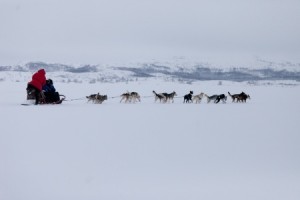 Reaching its peak in popularity in the 1980’s, dog mushing is a sport or a transport method utilizing dogs, primarily Siberian Huskies. Often times, there is a team of dogs that is pulling a sled which can sometimes be used for races, or for pulling cargo through a snowy area.
Reaching its peak in popularity in the 1980’s, dog mushing is a sport or a transport method utilizing dogs, primarily Siberian Huskies. Often times, there is a team of dogs that is pulling a sled which can sometimes be used for races, or for pulling cargo through a snowy area.
It’s called mushing because the French word “marche” meaning “to go” or “to run” was used back when it was first popular. However, over time, the English Canadians began to say “mush” instead.
The practice of using dogs to pull sleds dates back to 2000 BC. It originated in North America, where many natives would use dogs to pull heavy loads. As the French later settled in the America’s, they learned about their cultures and also started to use dogs in the same manner.
In 1911, a Norwegian explorer named Roald Amndsen used sled dogs in order to race, and was also the first to reach the South Pole. However his competitor, Robert Falcon Scott, used Siberian ponies instead and tragically died during the race.
Mushing as a sport is practiced worldwide, but definitely has a focus in North America, Northern Europe and the Alps. Associations such as the International Federation of Sleddog Sports and the International Sled Dog Racing Association are currently working to take dog mushing to the Olympics.
While the racing is more publicized, mushing also thrives as a fun and healthy way for families and individuals to get some exercise during the winter months. Dogs have even replaced snowmobiles for many, as they tend to be more reliable in the cold, bitter winter months.
The titles of the dog members depend on their position relative to the led. There are lead dogs, swing dogs, team dogs, and wheel dogs.
Lead Dogs: They steer the rest of the team, and they set the pace. It is more common now to have two leads, but singular leaders were more popular in the past. In some occasions the lead dog(s) would be free to find the trail for the rest of the dogs, but this is not allowed in the races.
Swing Dogs: These are directly behind the leader(s). They are called swing dogs because they swing the rest of the team behind them on turns or curves while on the trail.
Team Dogs: These dogs are located in between the wheel and swing dogs, and they add power and strength to the team. If a team is smaller, they may not have any team dogs. And sometimes, this term is lightly used to describe any dog on the team.
Wheel Dogs: These are nearest to the sled and the musher. These dogs need to be calmed natured; they can’t be started by the sled moving right behind them. Strength and perseverance are the characteristics sought after in these dogs.
The 1st Alaska Outdoor School is hosting a winter program from November 1st to April 10th. We encourage you to learn more about dog mushing in a hands-on environment and enjoy all out program has to offer! This includes the northern lights, dog sledding, and ice fishing.
If this sounds like something you’re interested in, contact us today!